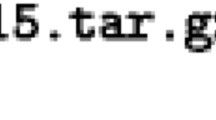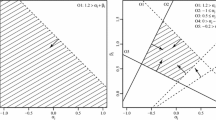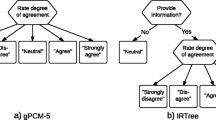Abstract
It is common practice in IRT to consider items as fixed and persons as random. Both, continuous and categorical person parameters are most often random variables, whereas for items only continuous parameters are used and they are commonly of the fixed type, although exceptions occur. It is shown in the present article that random item parameters make sense theoretically, and that in practice the random item approach is promising to handle several issues, such as the measurement of persons, the explanation of item difficulties, and trouble shooting with respect to DIF. In correspondence with these issues, three parts are included. All three rely on the Rasch model as the simplest model to study, and the same data set is used for all applications. First, it is shown that the Rasch model with fixed persons and random items is an interesting measurement model, both, in theory, and for its goodness of fit. Second, the linear logistic test model with an error term is introduced, so that the explanation of the item difficulties based on the item properties does not need to be perfect. Finally, two more models are presented: the random item profile model (RIP) and the random item mixture model (RIM). In the RIP, DIF is not considered a discrete phenomenon, and when a robust regression approach based on the RIP difficulties is applied, quite good DIF identification results are obtained. In the RIM, no prior anchor sets are defined, but instead a latent DIF class of items is used, so that posterior anchoring is realized (anchoring based on the item mixture). It is shown that both approaches are promising for the identification of DIF.
Similar content being viewed by others
References
Adams, R., Wilson, M., & Wu, M. (1997). Multilevel item response models: An approach to errors in variables regression. Journal of Educational and Behavioral Statistics, 22, 47–76.
Albers, W., Does, R.J.M.M., Ombos, Tj., & Janssen, M.P.E. (1989). A stochastic growth model applied to tests of academic knowledge. Psychometrika, 54, 451–466.
Andersen, E.B. (1980). Discrete statistical models with social science applications. Amsterdam: North-Holland.
Angoff, W.H., & Ford, S.F. (1973). Item-race interaction on a test of scholastic aptitude. Journal of Educational Measurement, 10, 95–106.
Bates, D., Maechler, M., & Dai, B. (2008). The lme4 Package version 0.999375-26. http://cran.r-project.org/web/packages/lme4/lme4.pdf/.
Bejar, I.I. (1993). A generative approach to psychological and educational measurement. In N. Frederiksen, R.J. Mislevy, & I.I. Bejar (Eds.), Test theory for a new generation of tests (pp. 323–359).
Bejar, I.I., Lawless, R.R., Morley, M.E., Wagner, M.E., Bennett, R.E., & Revuelta, J. (2003). A feasibility study of on-the-fly item generation in adaptive testing. Journal of Technology, Learning, and Assessment, 2, 1–29.
Bock, R.D., & Mislevy, R.J. (1982). Adaptive EAP estimation of ability in a microcomputer environment. Applied Psychological Measurement, 6, 431–444.
Briggs, D.C., & Wilson, M. (2007). Generalizability in item response modeling. Journal of Educational Measurement, 44, 131–155.
Camilli, G., & Shepard, L.A. (1994). Methods for identifying biased test items. Sage: Thousand Oaks.
Chen, Z., & Henning, G. (1985). Linguistic and cultural bias in proficiency tests. Language Testing, 2, 155–163.
Cho, S.-J., & Rabe-Hesketh, S. (2008). Estimating item response models with random item parameters. Unpublished manuscript.
Clark, H.H. (1973). The language-as-fixed-effect fallacy: A critique of language statistics in psychological research. Journal of Verbal Learning and Verbal Behavior, 12, 335–359.
Coleman, E.B. (1964). Generalizing to a language population. Psychological Reports, 14, 219–226.
De Boeck, P., & Wilson, M. (2004). Explanatory item response models. New York: Springer.
De Boeck, P., Wilson, M., & Acton, S. (2005). A conceptual and psychometric framework for distinguishing categories and dimensions. Psychological Review, 112, 129–158.
Dorans, N.J., & Holland, P.W. (1993). DIF detection and description: Mantal-Haenszel and standardization. In P.W. Holland, & H. Wainer (Eds.), Differential item functioning (pp. 35–66). Hillsdale: Erlbaum.
Dorans, N.J., & Kulick, E. (1986). Demonstrating the utility of the standardization approach to assessing unexpected differential item performance on the Scholastic Aptitude Test. Journal of Educational Measurement, 23, 355–368.
Embretson, S.E. (1999). Generating items during testing: Psychometric issues and models. Psychometrika, 64, 407–433.
Fischer, G.H. (1973). The linear logistic test model as an instrument in educational research. Acta Psychologica, 37, 359–374.
Frederickx, S., Tuerlinckx, F., De Boeck, P., & Magis, D. (2008). An item mixture model to detect differential item functioning. Unpublished manuscript, K.U. Leuven.
Gelman, A., & Rubin, D. (1992). Inference from iterative simulation using multiple sequences. Statistical Science, 7, 457–411.
Glas, C.A.W., & van der Linden, W.J. (2003). Computerized adaptive testing with item cloning. Applied Psychological Measurement, 27, 247–261.
Hively, W., Patterson, H.L., & Page, S.H. (1968). A “universe-defined” system of arithmetic achievement tests. Journal of Educational Measurement, 5, 275–290.
Holland, P.W., & Thayer, D.T. (1988). Differential item performance and the Mantel-Haenszel procedure. In H. Wainer & J.I. Braun (Eds.), Test validity (pp. 129–145). Hillsdale: Lawrence Erlbaum.
Holland, P.W., & Wainer, H. (1993). Differential item functioning. Hillsdale: Lawrence Erlbaum.
Ironson, G.H., Homan, S., Willis, R., & Singer, B. (1984). The validity of item bias techniques with math word problems. Applied Psychological Measurement, 8, 391–396.
Janssen, R., Tuerlinckx, F., Meulders, M., & De Boeck, P. (2000). A hierarchical IRT model for criterion-referenced measurement. Journal of Educational and Behavioral Statistics, 25, 285–306.
Janssen, R., Schepers, J., & Peres, D. (2004). Models with item and item group predictors. In P. De Boeck & M. Wilson (Eds.), Explanatory item response models: A generalized linear and nonlinear approach (pp. 189–212). New York: Springer.
Johnson, P.M., & Sinharay, S., (2005). Calibration of polytomous item families using Bayesian hierarchical modeling. Applied Psychological Measurement, 29, 369–400.
Lunn, D., Thomas, A., Best, N., & Spiegelhalter, D. (2000). WinBUGS—a Bayesian modelling framework: Concepts, structure, and extensibility. Statistics and Computing, 10, 325–337.
Mantel, N., & Haenszel, W. (1959). Statistical aspects of the analysis of data from retrospective studies of disease. Journal of the National Cancer Institute, 22, 719–748.
McGraw, K.O., & Wong, S.P. (1996). Forming inferences about some intraclass correlation coefficients. Psychological Methods, 1, 30–46.
Millsap, R.E., & Everson, H.T. (1993). Methodology review: Statistical approaches for assessing measurement bias. Applied Psychological Measurement, 17, 297–334.
Raaijmakers, J., Schrijnemakers, J., & Gremmen, F. (1999). How to deal with “the language-as-fixed-effect-fallacy”: Common misconceptions and alternative solutions. Journal of Memory and Language, 41, 416–426.
Popham, W.J. (1978). Criterion-referenced measurement. Englewood Cliffs: Prentice-Hall.
Rouder, J.N., Lu, J., Speckman, P.L., Sun, D., Morey, R.D., & Naveh-Benjamin, M. (2007). Signal detection models with random participant and random item effects. Psychometrika, 72, 621–624.
Rousseeuw, P.J., & Leroy, A.M. (1987). Robust regression and outlier detection. New York: Wiley.
Rousseeuw, P.J., & van Driessen, K. (1999). A fast algorithm for the minimum covariance determinant estimator. Technometrics, 41, 212–223.
Roussos, L.A., Templin, J.L., & Henson, R.A. (2007). Skills diagnosis using IRT-based latent class models. Journal of Educational Measurement, 44, 293–311.
Savalei, V. (2006). Logistic approximation to the normal: The KL rationale. Psychometrika, 71, 763–767.
Shrout, P.E., & Fleiss, J.L. (1979). Intraclass correlation: Uses in assessing reliability. Psychological Bulletin, 86, 420–428.
Shepard, L., Camilli, G., & Williams, D.M. (1985). Validity of approximation techniques for detecting item bias. Journal of Educational Measurement, 22, 77–105.
Sinharay, S., Johnson, M.S., & Williamson, D.M. (2003). Calibrating item families and summarizing the results using family expected response functions. Journal of Educational and Behavioral Sciences, 28, 295–313.
Snijders, T.A.B., & Bosker, R.J. (1999). Multilevel analysis. An introduction to basic and advanced multilevel modeling. London: Sage.
StataCorp (2007). Stata statistical software: Release 10. College Station: StataCorp LP.
Swaminathan, H., & Rogers, H.J. (1990). Detecting differential item functioning using logistic regression procedures. Journal of Educational Measurement, 27, 361–70.
Tan, E.S., Ambergen, A.W., Does, R.J.M.M., & Imbos, Tj. (1999). Approximations of normal IRT models for change. Journal of Educational and Behavioral Statistics, 24, 208–223.
Teresi, J.A. (2001). Statistical methods for examination of differential item functioning (DIF)—with applications to cross-cultural measurement of functional, physical and mental health. Journal of Mental Health and Aging, 7, 31–40.
Thierny, L., & Kadane, J.R. (1986). Accurate approximations for the posterior moments and marginal densities. Journal of the American Statistical Association, 81, 82–86.
Thissen, D., Steinberg, L., & Gerrard, M. (1986). Beyond group-mean differences: The concept of item bias. Psychological Bulletin, 99, 118–128.
Tuerlinckx, F., Rijmen, F., Verbeke, G., & De Boeck, P. (2006). Statistical inference in generalized linear mixed models: A review. British Journal of Mathematical and Statistical Psychology, 59, 225–255.
Van den Noortgate, W., De Boeck, P., & Meulders, M. (2003). Cross-classification multilevel logistic models in psychometrics. Journal of Educational and Behavioral Statistics, 28, 369–386.
Verhelst, N.D., & Eggen, T.J.H.M. (1989). Psychometrische en statistische aspecten van peilingsonderzoek (PPON rapport 4). Arnhem: Cito.
Wang, W.-C. (2004). Effects of anchor item methods on the detection of differential item functioning within the family of Rasch models. Journal of Experimental Education, 72, 221–261.
Zwinderman, A.H. (1991). A generalized Rasch model for manifest predictors. Psychometrika, 56, 589–600.
Author information
Authors and Affiliations
Corresponding author
Rights and permissions
About this article
Cite this article
De Boeck, P. Random Item IRT Models. Psychometrika 73, 533–559 (2008). https://doi.org/10.1007/s11336-008-9092-x
Published:
Issue Date:
DOI: https://doi.org/10.1007/s11336-008-9092-x




